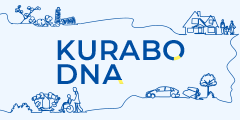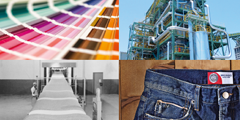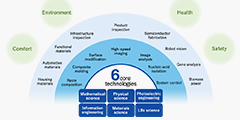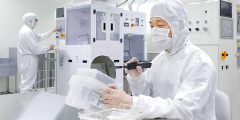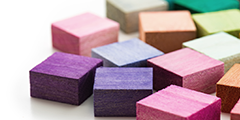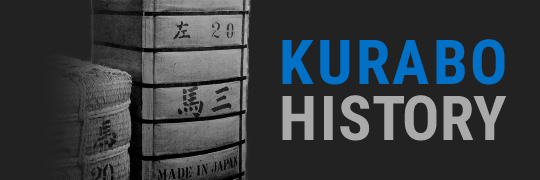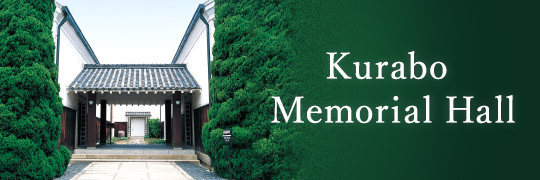ChronologyCompany Information
1880s
1888
Kurashiki Spinning Works was founded.
1889
The Kurashiki Head Office Mill (now Kurashiki Ivy Square) was completed.
1890s
1893
Following the enactment of Japan’s Commercial Code, the company was renamed Kurabo Industries Ltd.
1895
Export of cotton yarn began under the Mitsuuma brand name.
1910s
1915
The Masu Mill (later renamed the Kurashiki Mill) was completed. (It operated until 1992.)
1917
The in-house publication Kurashiki News (now Doushin) made its first appearance.
1919
The Ohara Institute for Social Research was established by the company’s president, Magosaburo Ohara.
1920s
1921
The Kurashiki Labor Science Institute (now the Ohara Memorial Institute for Science of Labor) was established.
The Hayashima Mill was established. (It operated until 1994.)
1922
The Okayama Kitakata Plant (later renamed the Okayama Mill) was established. (It operated until 2009.)
1923
The Kurabo Central Hospital (now Kurashiki Central Hospital) was opened.
1924
The Hirakata Plant was established. (It operated until 1996.)
1926
Kurashiki Kenshoku Co., Ltd. (now Kuraray Co., Ltd.) was established.
1930s
1930
The Ohara Museum of Art was established by the company’s president, Magosaburo Ohara.
1933
The head office was relocated to Osaka.
The Kanonji and Marugame Mills were established. (The Kanonji and Marugame Mills operated until 2008 and 2020, respectively.)
1935
Kurashiki Woolen Weaving Co. (later renamed the Tsu Mill) was established to branch out into the wool business. (It operated until 2009.)
1938
The Hojo Mill was completed. (It operated until 2013.)
1940s
1942
The Kisogawa Mill was established. (It operated until 2001.)
The Tokyo Office (now the Tokyo Branch) was opened.
1944
The company was renamed Kurashiki Industries Ltd.
1945
The company lost nearly 70 percent of its total production facilities as a result of World War II.
1946
The company name changed back to Kurabo Industries Ltd.
1948
Sanyo Lace Co., Ltd. (now Kurashiki Textile Manufacturing Co., Ltd.) was established.
1950s
1950
The Masu Mill’s women’s volleyball team won the All-Japan Corporate Athletics Meet.
1951
The Anjo Mill was completed.
Koei Shoji Co., Ltd. was established.
1953
An agreement was signed with Fujii Co., Ltd. for the use of the Ski Yarn brand name.
Masu Sangyo Co., Ltd. (later renamed Masty Kurashiki Co., Ltd.) was established. (It operated until 2015.)
1954
Kyodo Yomo Kogyo (later renamed Kurashiki Woolen Mfg. Co., Ltd.) was established. (It operated until 2000.)
1955
The New York Office was opened. (It operated until 2009.)
1957
Lanificio Kurashiki do Brasil S.A. (now Kurashiki do Brasil Textil Ltda.) was established in Brazil.
1958
Kurashiki Dyeing Co., Ltd. was established. (It operated until 2007.)
1960s
1962
Japan Instant Foods (now Japan Jiffy Foods, Inc.) became affiliated.
National Linen Supply Co., Ltd. (later renamed Kurabo Linen Supply Co., Ltd.) was established. (It operated until 2007.)
The Neyagawa Plant was completed to branch out into the polyurethane foam business.
1963
The Chemical Products Division was launched.
Kurabo Driving School Co., Ltd. was established.
1964
The Technical Research Laboratory was completed.
The Hamburg Office was opened (relocated from Düsseldorf.) (It operated until 1993.)
1968
Thai Kurabo Co., Ltd. was established in Thailand.
1969
The Kurabo Memorial Hall was completed.
Shinsanyo Co., Ltd. was established. (It operated until 2006.)
Chugoku Kasei Kogyo Co., Ltd. became affiliated.
Agata Boseki (now Taishoboseki Industries Ltd.) was established.
Tomei Kasei Co., Ltd. was established.
1970s
1970
A flue gas desulfurization system was developed.
The Engineering Business Division (now the Engineering Division) was launched.
Ichikawa Kogyo (later renamed Kurabo Tokyo Kasei Co., Ltd.) became affiliated. (It operated until 2002.)
Entered the jeans denim market.
1971
Entered the market for synthetic wood and adhesives.
The Susono Plant was completed.
Entered the market for water treatment systems.
1972
Kurabo Kohatsu Co., Ltd. was established. (It operated until 1994.)
Cotonificio Kurashiki do Brazil Ltd. was established in Brazil. (It operated until 2006.)
1973
Kurashiki Ivy Square, Ltd. was established.
Nisseisha Co., Ltd. became affiliated. (It operated until 2000.)
Kurabo Apparel Ltd. (now Kurabo International Co., Ltd.) was established.
1974
Entered the market for sandwich panel heat-insulating materials used in construction.
P.T. Kurabo Manunggal Textile Industries was established in Indonesia.
A flue gas denitration and deodorization system was developed.
1976
Kurabo Engineering Work Service Co., Ltd. (now Kurabo Plant System Co., Ltd.) was established.
The Information Systems Development Department (later renamed the Information Development Business Division) was established.
Takamiya and Co., Ltd. (later renamed Kurabo Textile Corporation) became affiliated. (It operated until 2010.)
1978
Kurabo Kansai Kasei Co., Ltd. was established.
Started marketing Aucolor, a computer color matching system.
Aris, a production control system for sewing factories, was developed.
1979
Bondream Co., Ltd. was established. (It operated until 2008.)
1980s
1980
The Non-Textile Business Development Group (later renamed the New Business Development Department) was launched. (It operated until 2010).
Color 7, a spectrophotometer, was developed.
1981
Aukitchen, equipment for automatically mixing and dispensing liquids, was developed.
A gravure printing system for construction materials was developed.
Rafics, an energy-saving system, was developed.
Sales began of linen material for clothing.
1982
Entered the market for filters and related products for biological research.
1983
Fermalino, a process for improving the quality of wool fabrics, was developed.
Aramis International Co., Ltd. was established.
1984
Uprise Co., Ltd. was established. (It operated until 2010.)
Entered the precision filtration market.
A flame lamination business was launched.
1985
The Information Systems Development Department (later renamed the Electronics Division) was upgraded to division status.
1986
An impregnation processing business was launched.
Entered the precision measuring instrument market.
Entered the market for fluororesin processed products.
Entered the CAD systems market.
1987
The Assets Promotion Project (A.P.P.) (now the Real Estate Division) was launched.
A flower business was launched. (It operated until 2010.)
Echo Giken Co., Ltd. was established.
The Hong Kong Office was established. (It operated until 2016.)
The Electronic Equipment Development Department (now the Electronic Application System Department) was launched.
1988
The new head office building was completed.
The Kurabo Management Philosophy was established.
“Kurabo” became an official company name.
The company’s centennial anniversary was celebrated on March 9.
Entered the market for human resource development.
TA, equipment for automatically monitoring color tones in patterned fabrics, was developed.
Century Techno Services (now Kurabo Techno System Ltd.) was established.
Entered the market for reagents for biological research and biochemical materials.
Aupier, a color design system, was developed.
Sales began of cell culture kits and culture media.
1989
The Gunma Plant was completed. Entered the inorganic construction material market.
K.M.E. Garments Co., Ltd. was established in Thailand. (It operated until 2003.)
1990s
1990
Sales began of nucleic-acid isolation systems.
Thai Textile Development and Finishing Co., Ltd. was established in Thailand.
1991
A comprehensive CAD drawing management system was developed.
The Neuro CCM computer color matching system was developed.
The Biomedical Department was launched.
1992
Aukitchen-VS, an automatic powder-dispensing device, was developed.
The Annex Building was completed.
Zhejiang Weinabang Fashion Co., Ltd. (later renamed Tongxiang Kurabo Fashion Co., Ltd.) in China became affiliated. (It operated until 2014.)
San-ei (Zhuhai) Textiles Co., Ltd. (later renamed Kurabo Denim (Zhuhai) Co., Ltd.) was established in China. (It operated until 2013.)
1993
Phoenix Kurabo Ltd. was established in China. (It operated until 2006.)
The Sen/Rem/Men washed-cotton project was launched.
A new shape-stabilizing process was developed.
The Düsseldorf Office was opened (relocated from Hamburg). (It operated until 2000.)
1994
The Anjo Apparel Products Center was established.
The Kamogata Plant was completed.
Internal committees for product liability countermeasures and the environment were established.
The Kurabo Neyagawa Building was completed.
P.T. Akurabenitama was established in Indonesia.
1995
Siam Kurabo Co., Ltd. was established in Thailand.
1996
The Tokushima Plant was completed.
KRK (HK) Ltd. (later renamed Kurabo Denim (HK) Ltd.) was established in China. (It operated until 2013.)
The Electronics Business Division (later changed to the Advanced Technology Business Division) was established.
1998
The Kurabo Code of Ethics (now the Kurabo Group Code of Ethics) was established.
2000s
2000
A non-AOX, ozone shrink-proof wool-processing treatment was developed.
2001
-
Guangzhou Kurabo Chemicals Co., Ltd. was established in China.
2002
Sales began of DNA chips and contracted analytical services.
2003
The Shanghai Representative Office was established. (It operated until 2009.)
2005
The Neyagawa Techno Center was established.
2006
Kurashiki do Brasil Textil Ltda. was established in Brazil.
The Kurabo CSR Committee was established.
The cotton synthetic textile division and the wool product division were consolidated (now the Textile Business Division).
Tongxiang Kurabo Fashion Co., Ltd. was established in China.
2007
Sheedom Co., Ltd. became affiliated.
2009
Kurabo Shanghai Co., Ltd. was established in China.
2010s
2010
Kurashiki Chemical Products do Brasil Ltda. was established in Brazil.
Kurabo International Co., Ltd. was established.
MK Apparels Ltd. was established in Bangladesh.
Kuraki Taiwan Co., Ltd. was established in Taiwan.
2011
Kuraki Co., Ltd. became a wholly owned subsidiary.
2012
The Mie Plant was completed.
The Kumamoto Development Center (now the Kumamoto Office and R&D Center) was completed.
2013
Kurabo Denim International Ltd. was established in China.
Guanzhou KFC Plastics Co., Ltd. in China became affiliated.
2016
A biomass power business was launched.
The Kurabo Advanced Technology Center was completed.
2018
Kurabo Vietnam Co., Ltd. was established in Vietnam.
2019
Yamabun Electronics Co., Ltd. became affiliated.
2020
Kurabo Chemical Works Co., Ltd. was established.
2021
Seiki Co., Ltd. became affiliated.

